The document discusses types in Haskell, explaining that Haskell is strongly typed and describing basic types like Int, Char, and Bool as well as more complex types like tuples, lists, and functions. It also covers type inference, polymorphism, and how to infer the behavior of functions from their types.
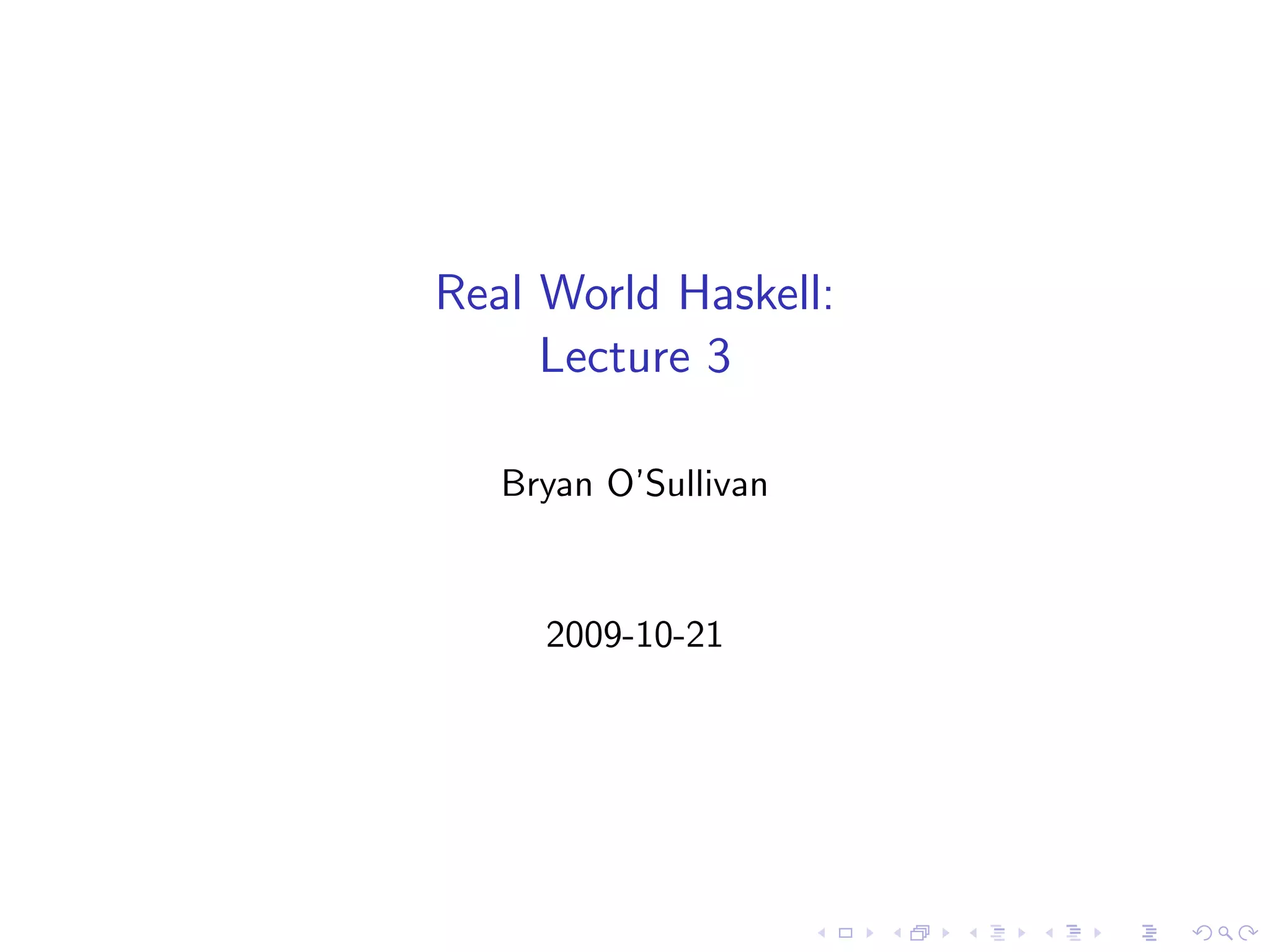
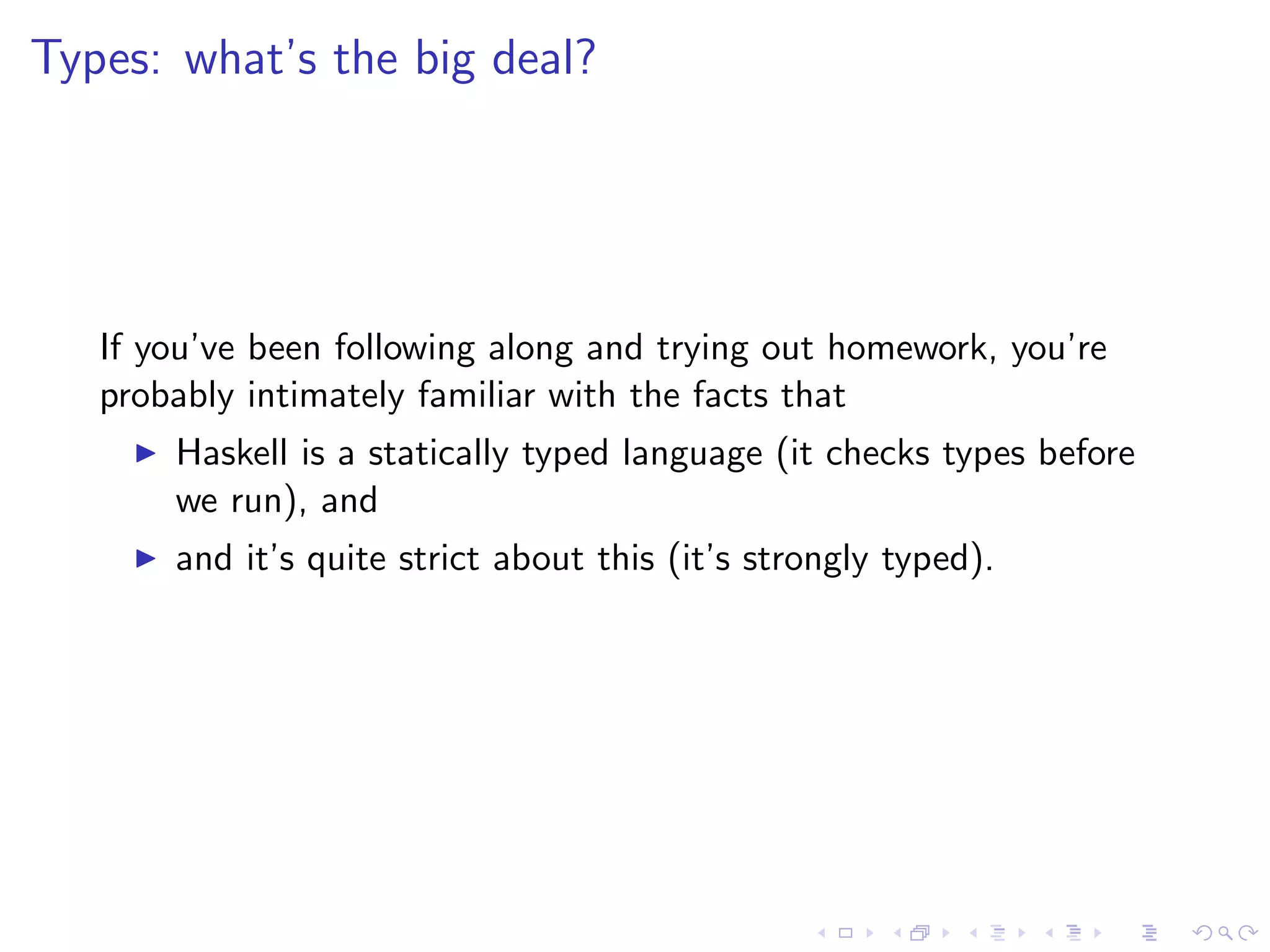
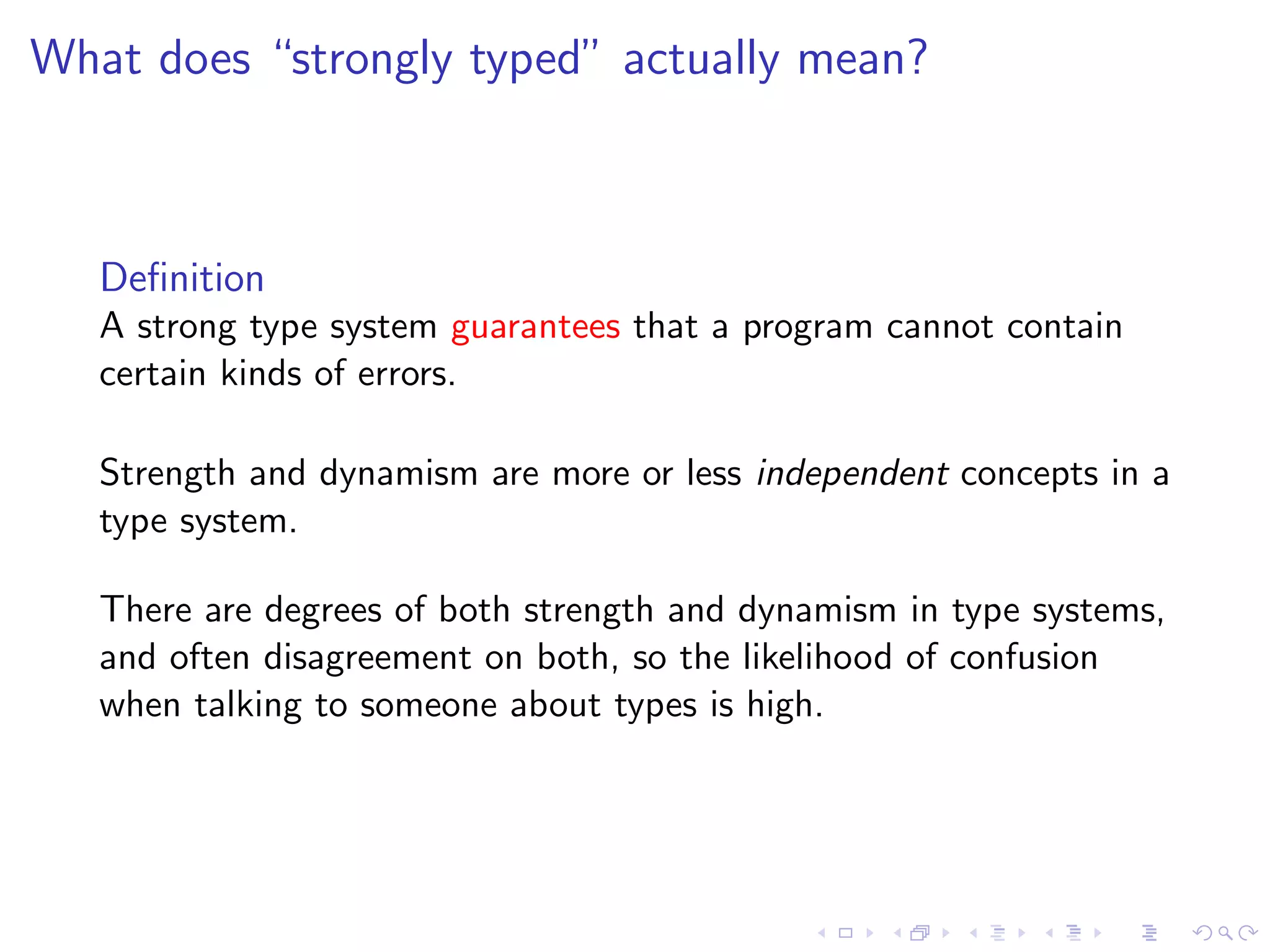
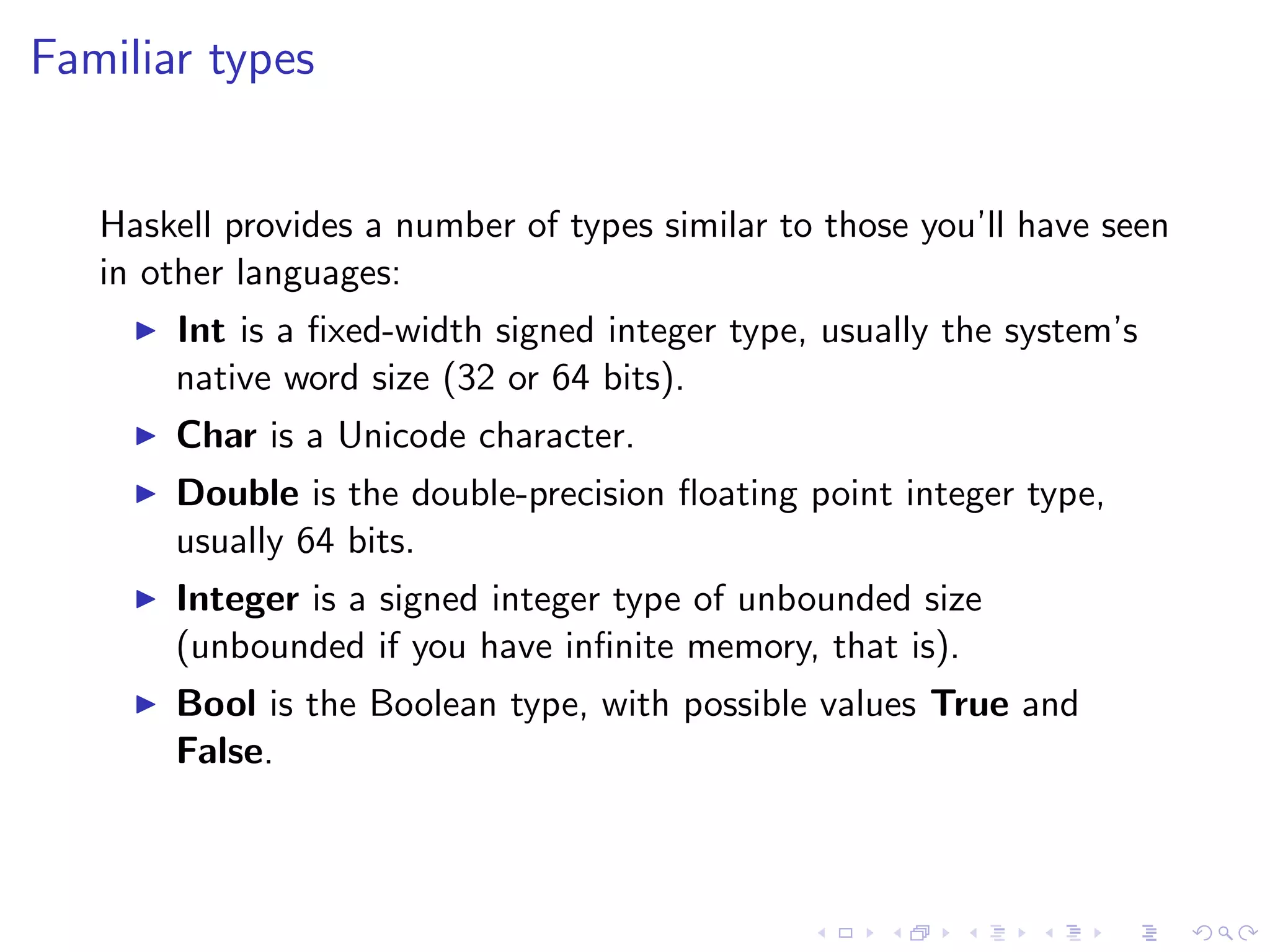
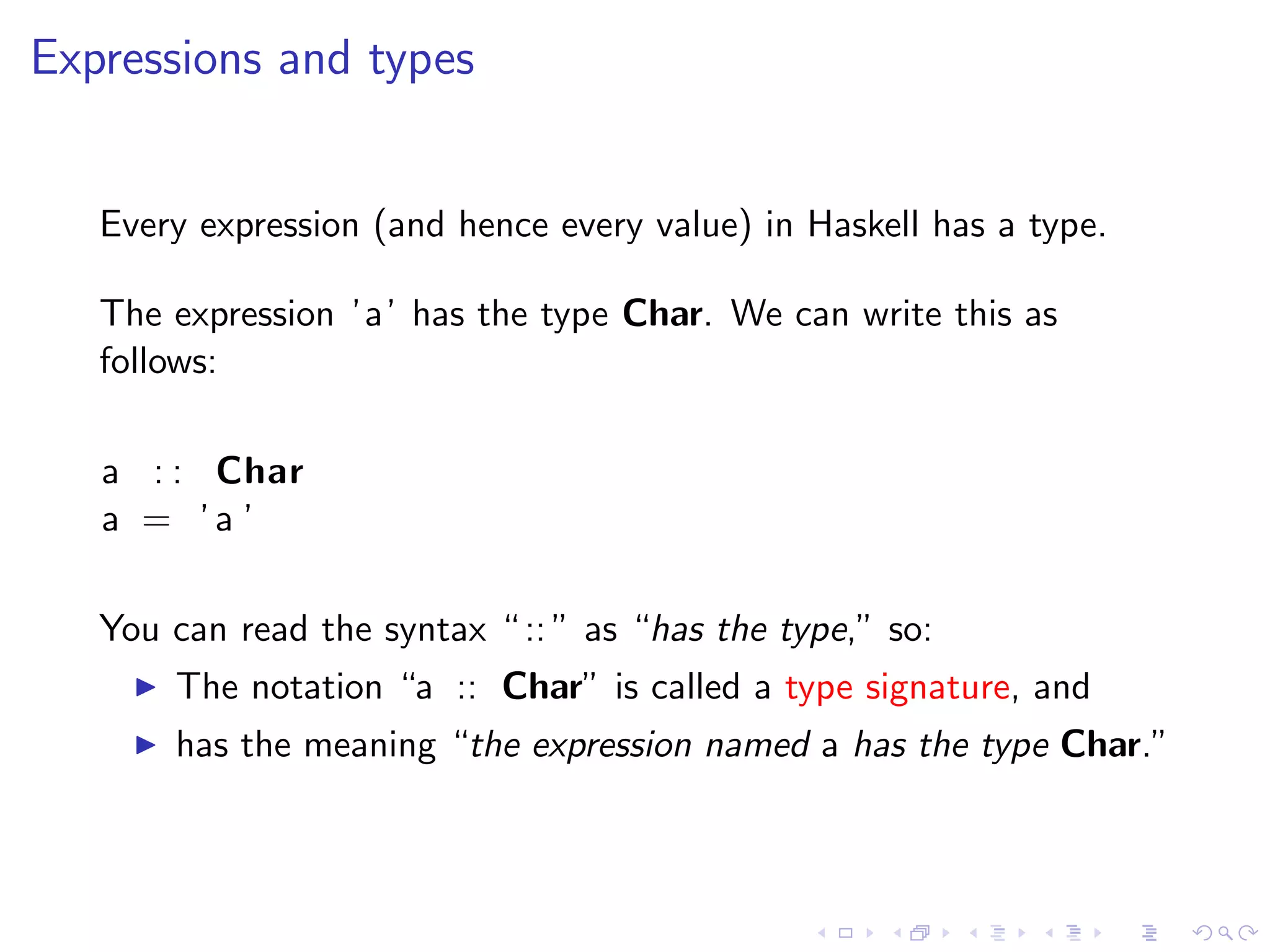
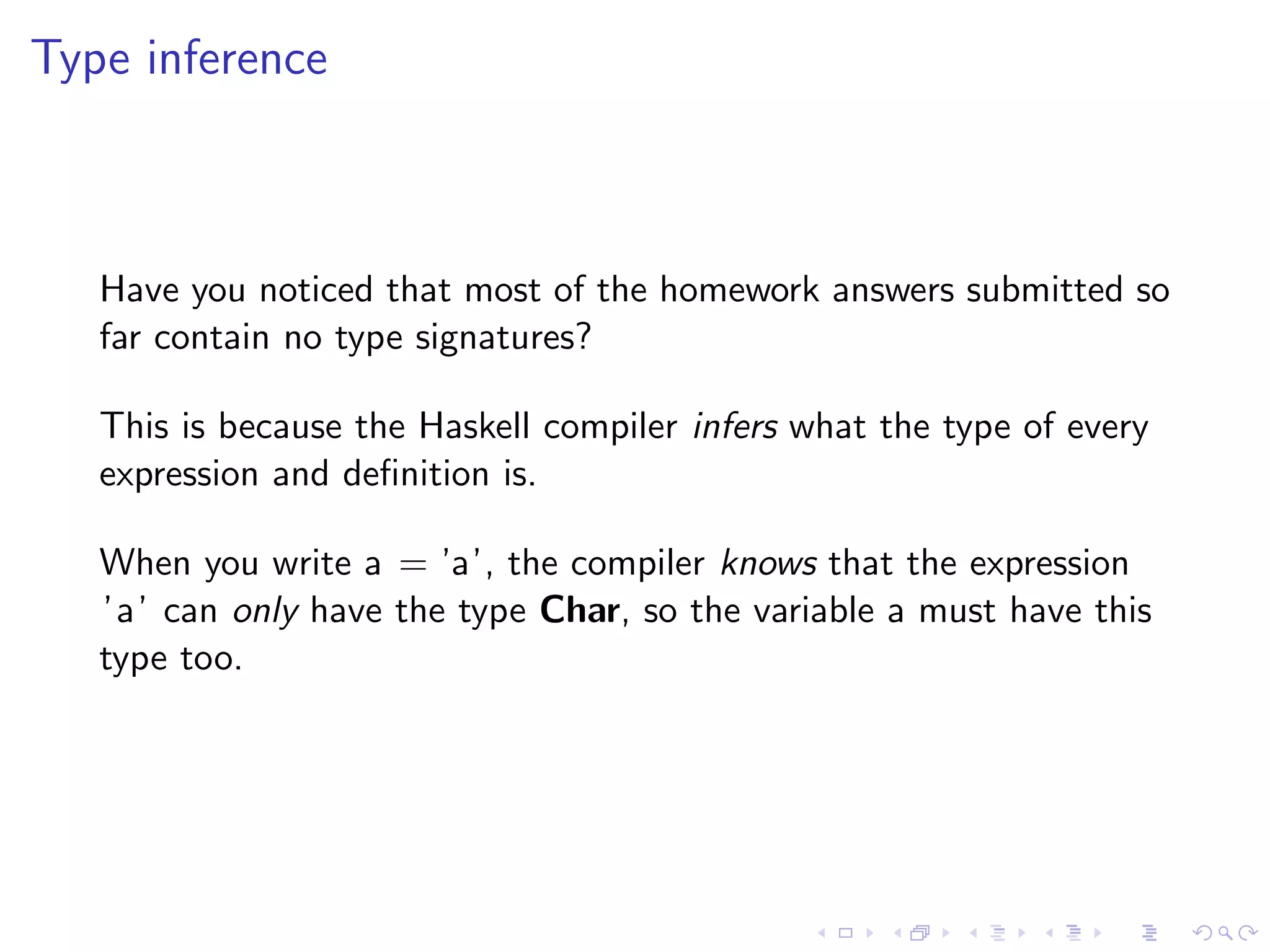
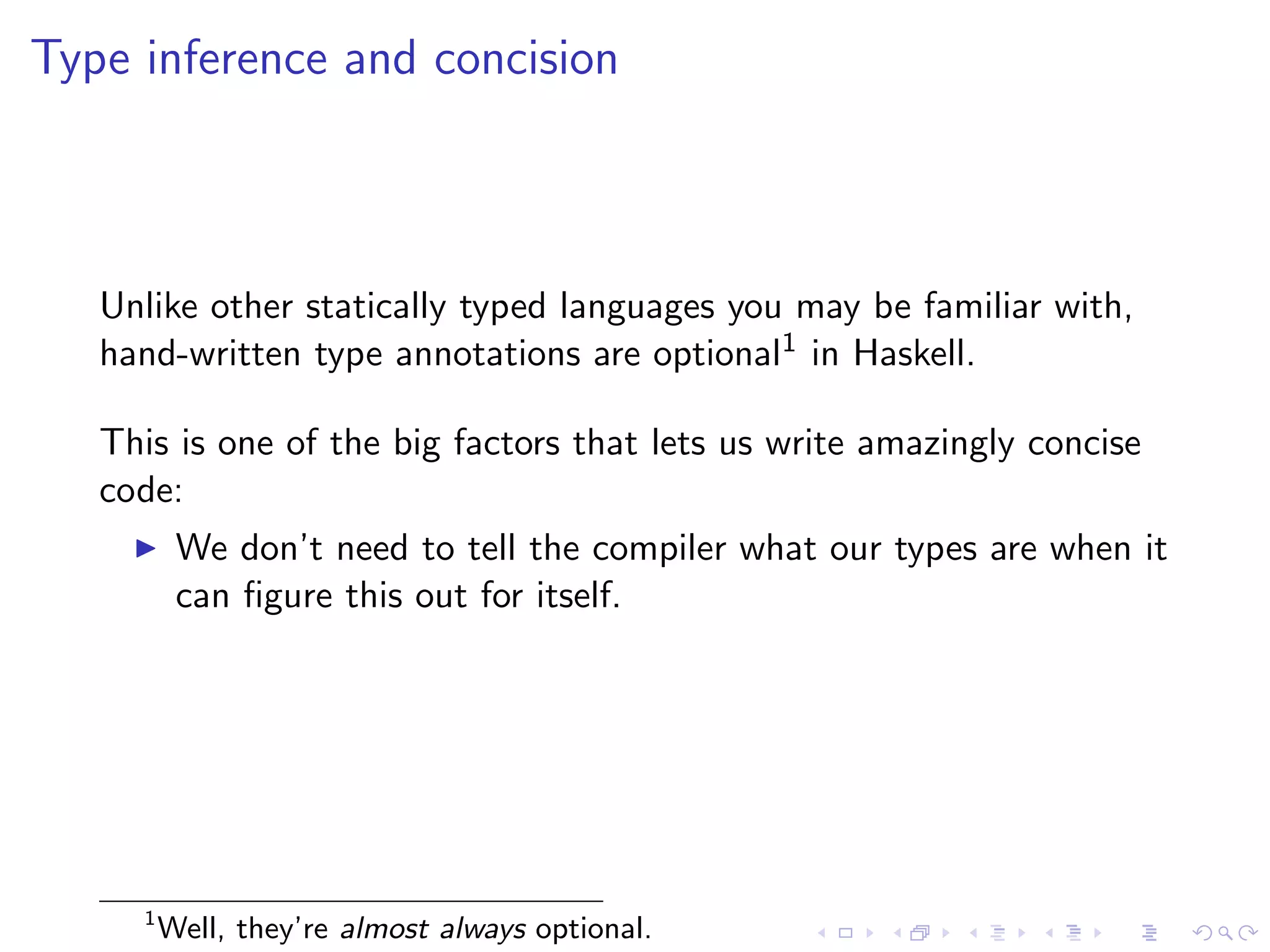
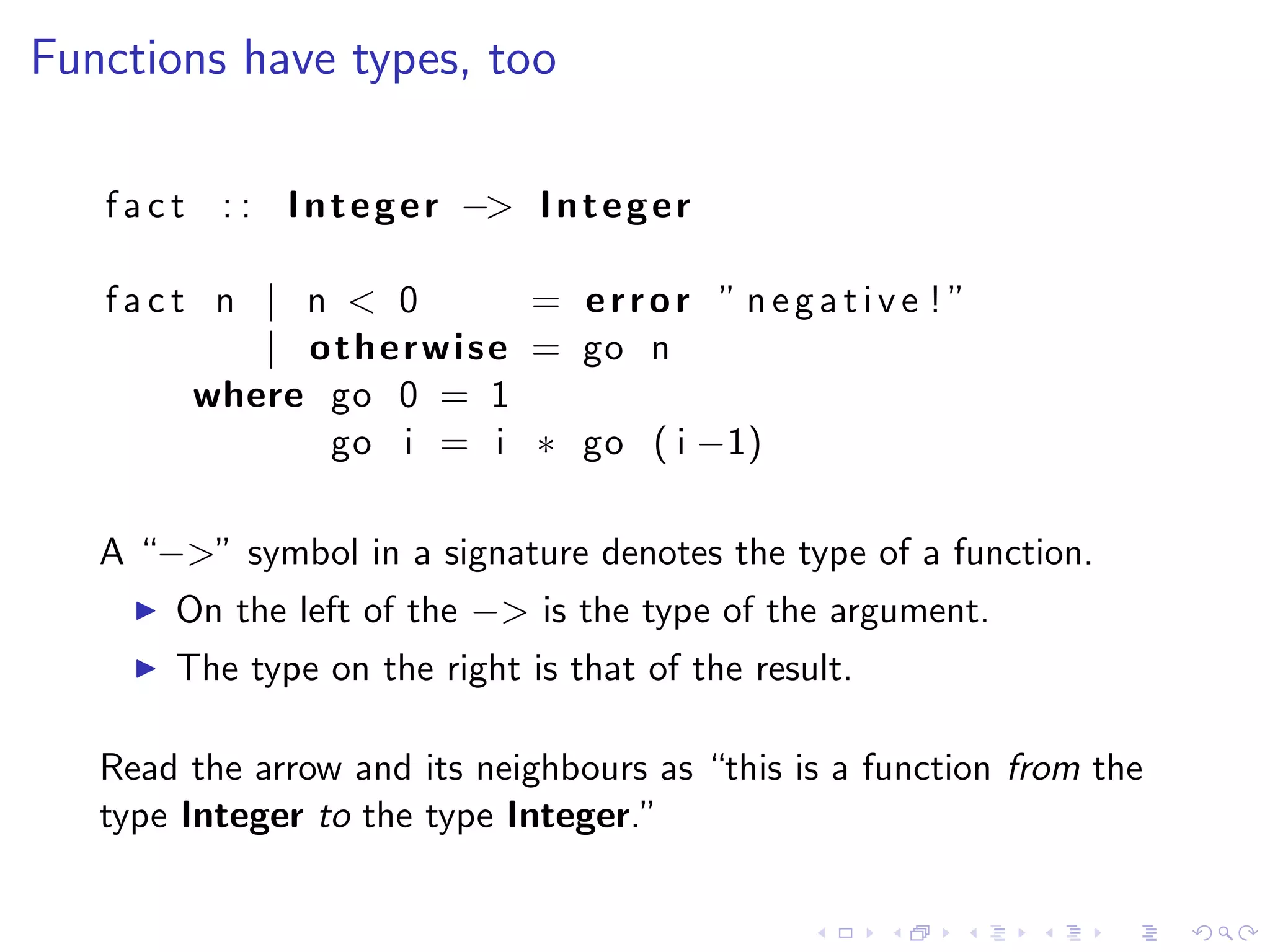
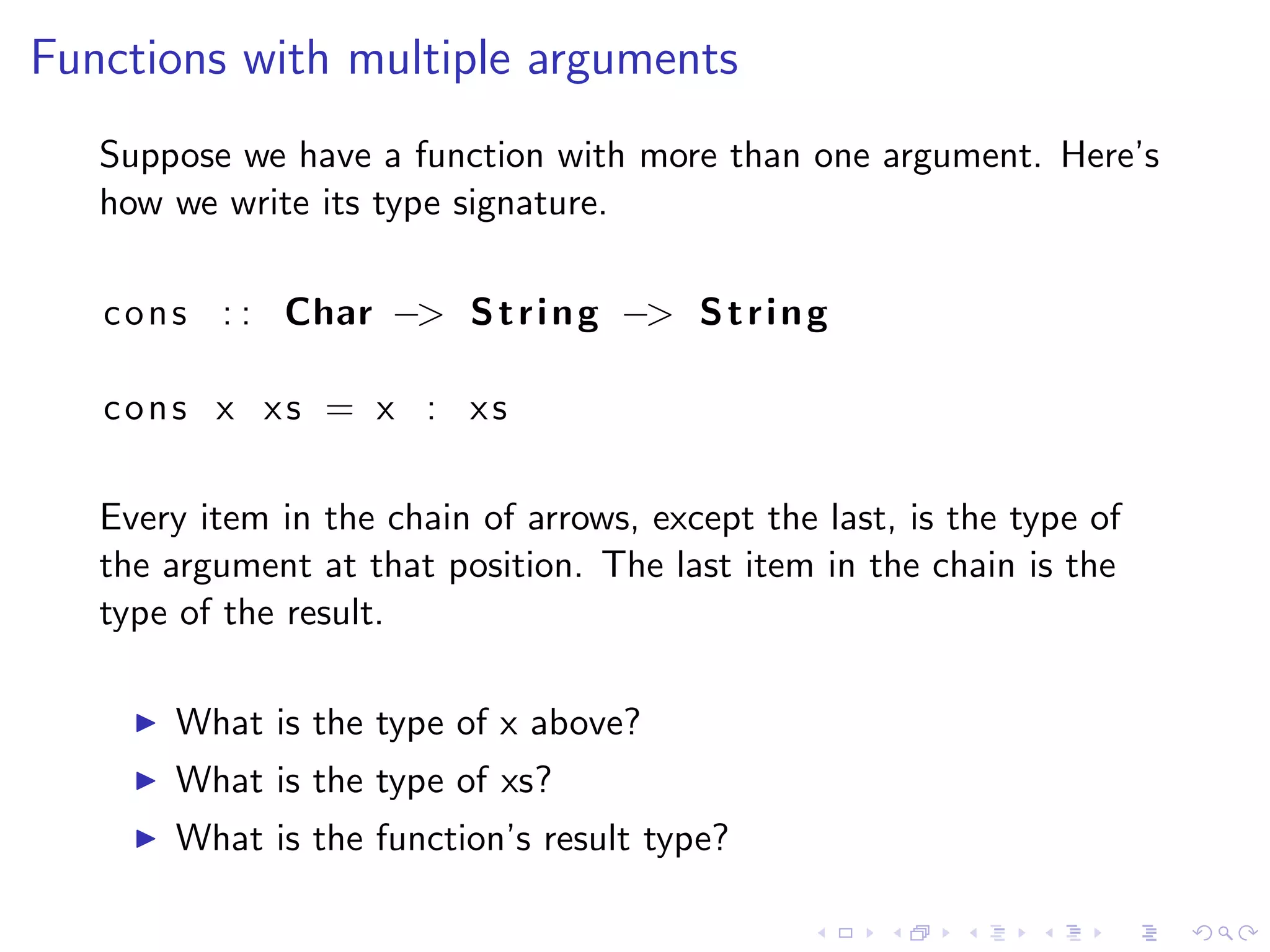
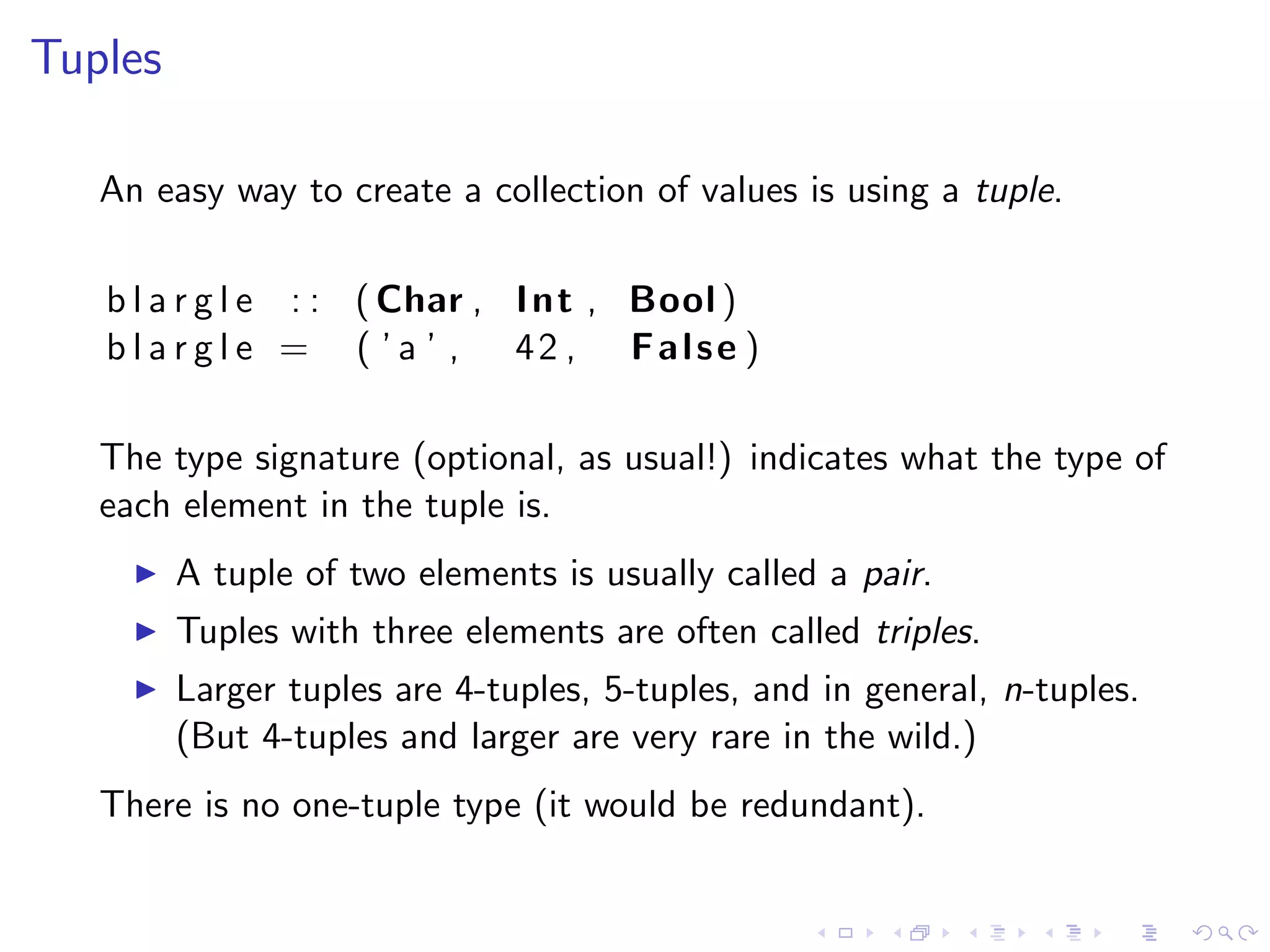
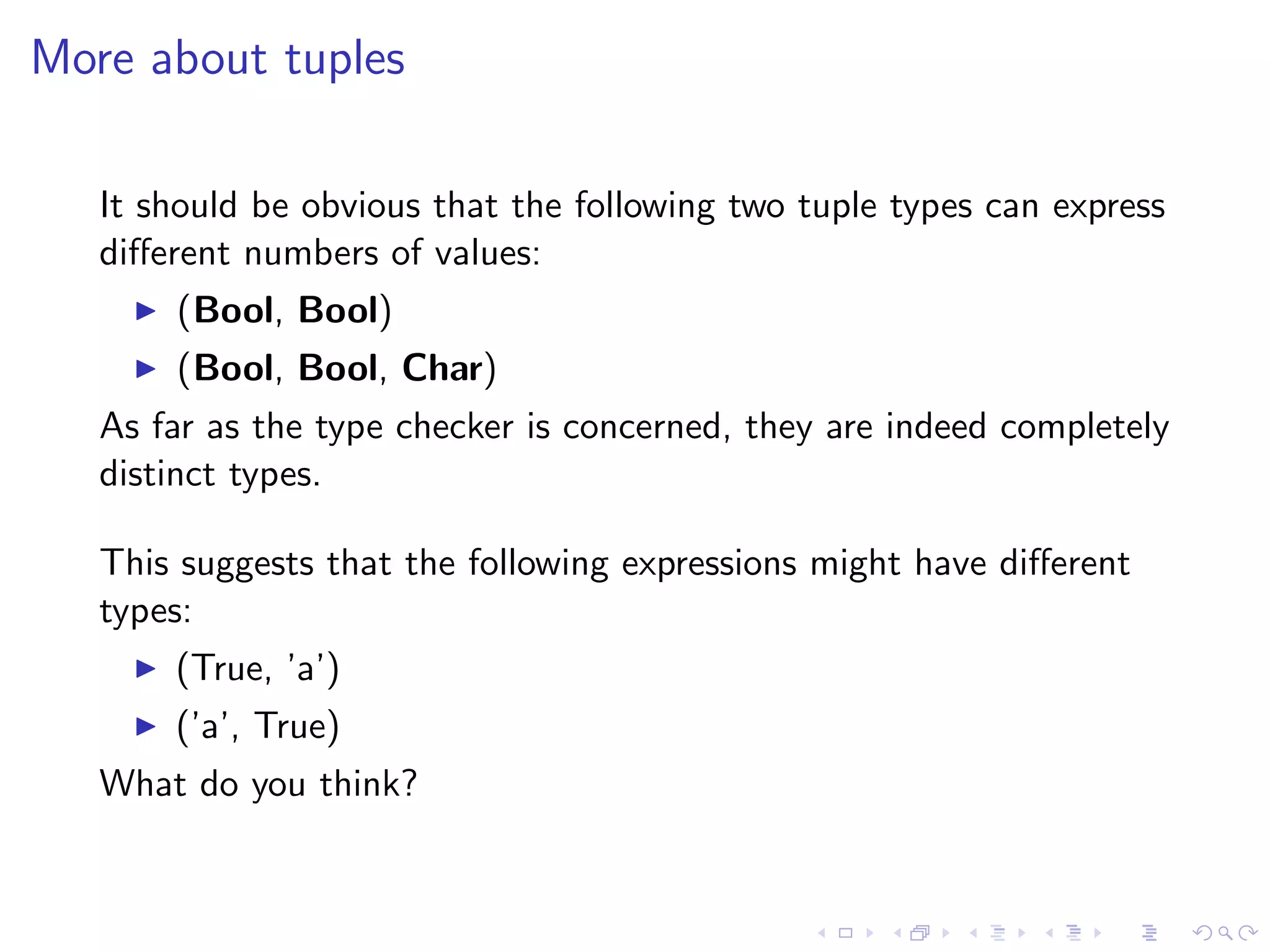
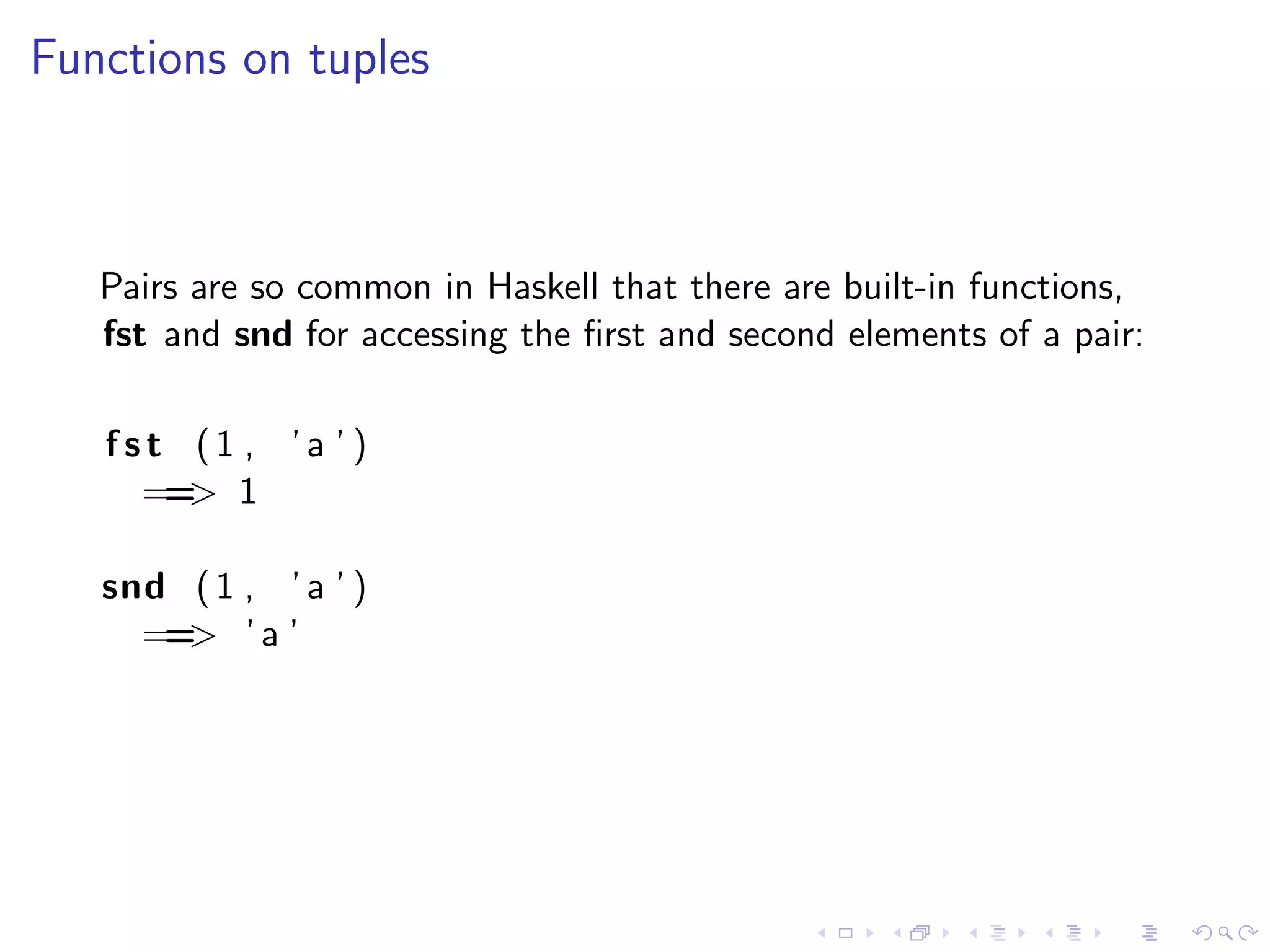
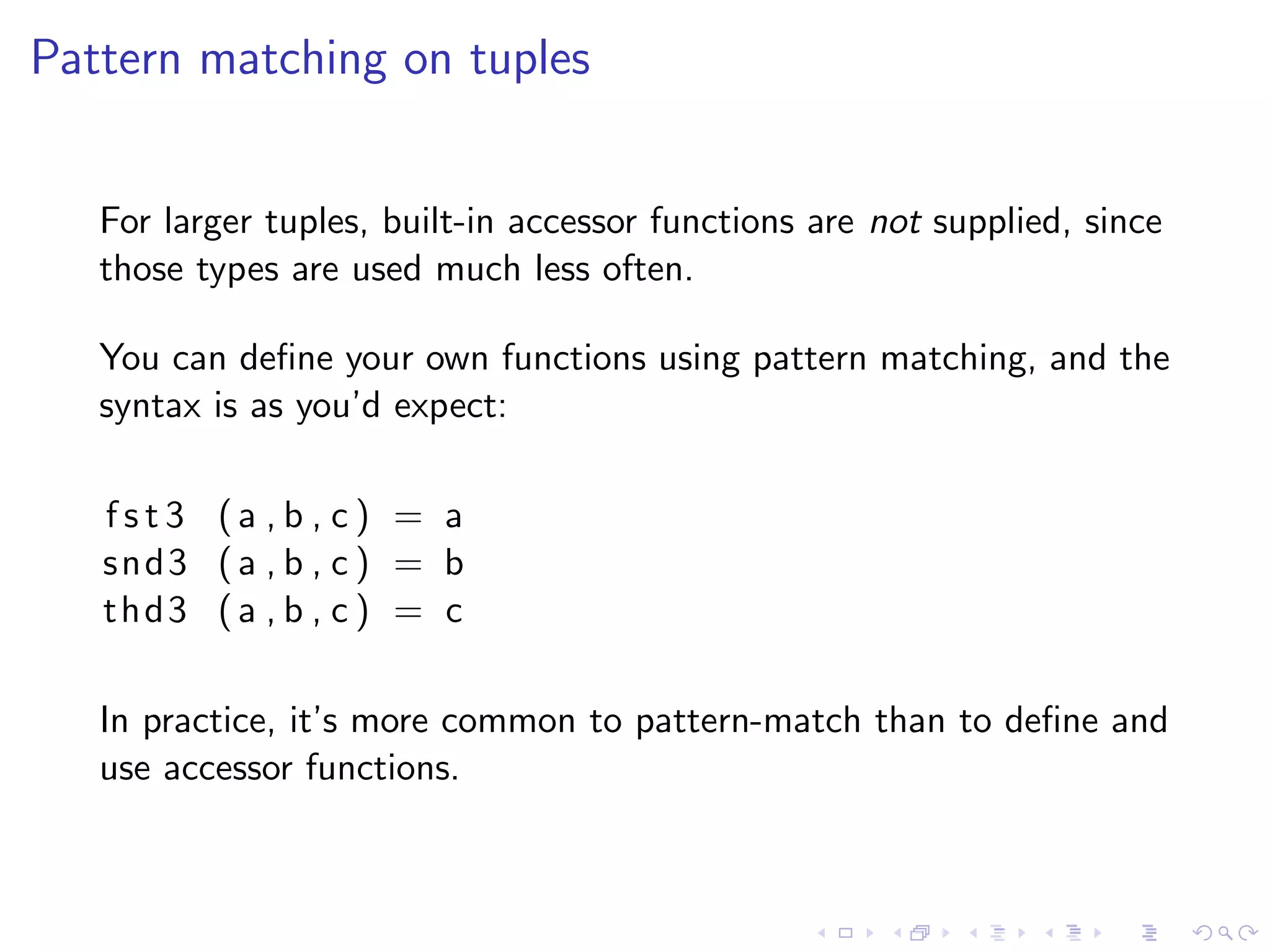
![The list type
The ghci interpreter has a very useful command, :type, for
figuring out what the type of an expression or function is.
Here’s an example:
Prelude> :type lines
lines :: String -> [String]
As this suggests, the notation for “list of String” is [String].
And as the notation suggests, every element in a list must have the
same type.](https://image.slidesharecdn.com/lecture3-091021030809-phpapp02/75/Real-World-Haskell-Lecture-3-14-2048.jpg)
![Type synonyms
Recall that a Haskell string is just a list of characters.
The type of a list of characters is [Char], but we often see String
in type signatures.
There is no magic at work here: String is just a synonym for
[Char]. The compiler treats them identically.
In fact, we can introduce our own type synonyms at will:
type S t r e e t N u m b e r = I n t
type StreetName = S t r i n g
type A d d r e s s = ( StreetNumber , StreetName )
(Think typedef, C programmers!)](https://image.slidesharecdn.com/lecture3-091021030809-phpapp02/75/Real-World-Haskell-Lecture-3-15-2048.jpg)
![Functions over lists
Type synonyms are only mildly interesting; I mentioned them
mainly to bring the String ≡ [Char] equivalence to the fore.
Here’s why: notice that most functions on lists don’t seem to care
what types the elements of those lists have:
drop 3 [ 0 . . 1 0 ]
== [ 3 , 4 , 5 , 6 , 7 ]
>
drop 5 ” a b a c i n a t e ”
== ” n a t e ”
>
What’s going on here?](https://image.slidesharecdn.com/lecture3-091021030809-phpapp02/75/Real-World-Haskell-Lecture-3-16-2048.jpg)
![Polymorphism
Consider the following function definition:
take n | n <= 0 = []
take [] = []
take n ( x : x s ) = x : take ( n−1) x s
The take function never inspects the elements of the list. It
neither knows nor cares what they are.
We call functions like this polymorphic over the list’s elements.](https://image.slidesharecdn.com/lecture3-091021030809-phpapp02/75/Real-World-Haskell-Lecture-3-17-2048.jpg)
![Polymorphic type signatures
How do we write the type signature for take?
take : : I n t −> [ a ] −> [ a ]
That name “a” above, inside the list brackets, is a type variable.
A type variable lets us say “I don’t know or care what concrete
type2 will be used in this position, so here’s a placeholder.”
2
“Concrete type”? Think Int, Char, etc.](https://image.slidesharecdn.com/lecture3-091021030809-phpapp02/75/Real-World-Haskell-Lecture-3-18-2048.jpg)
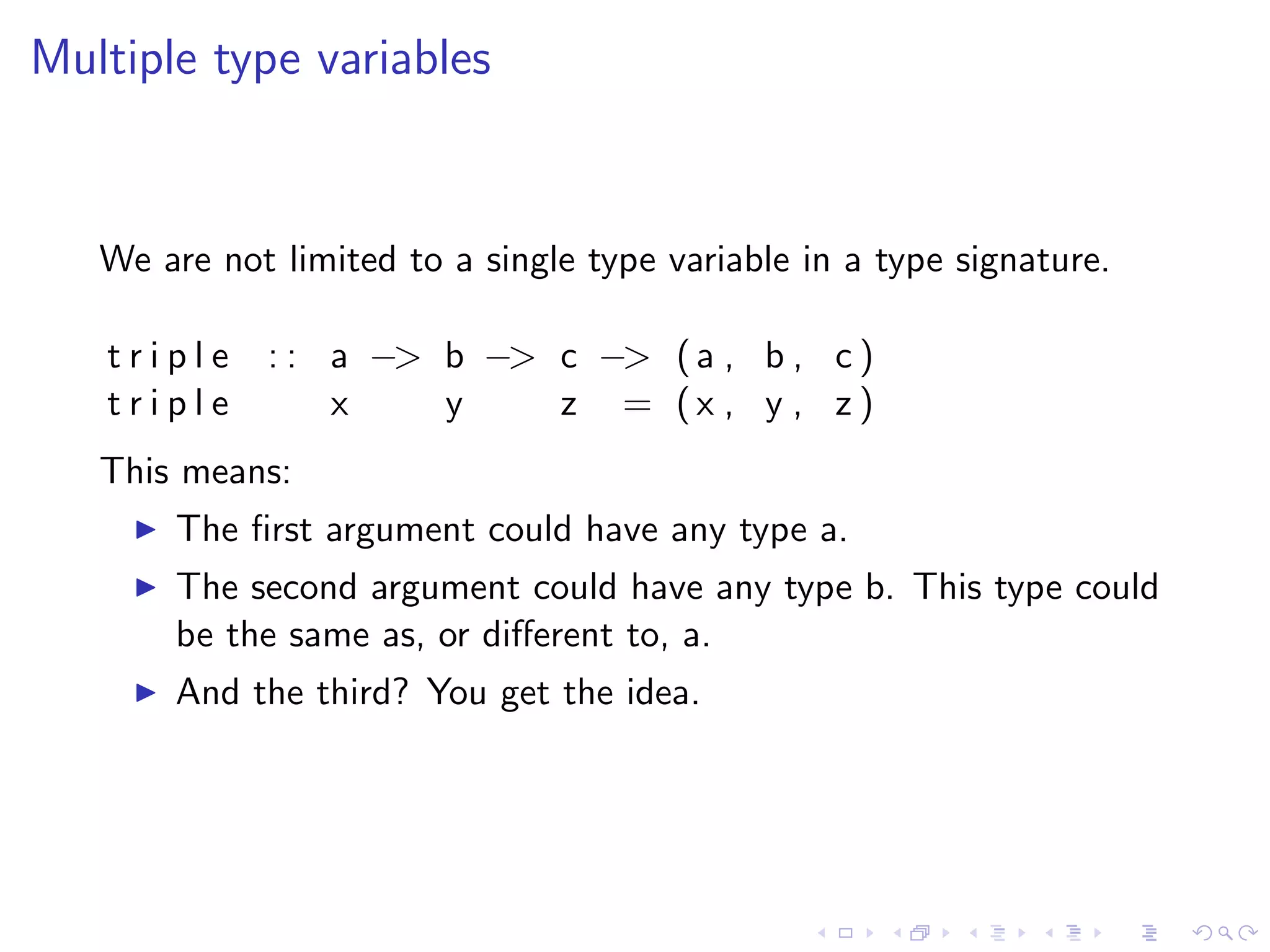
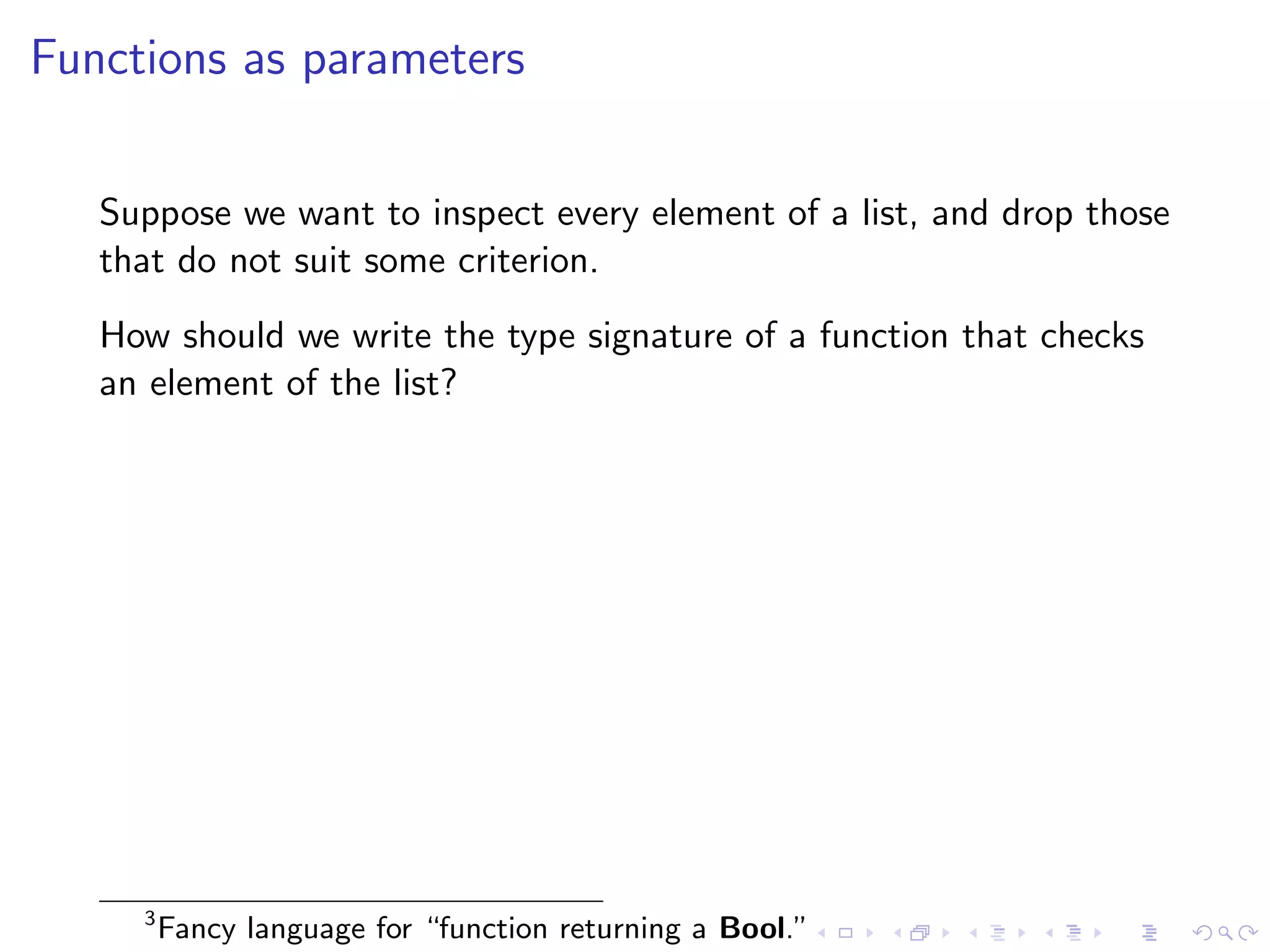
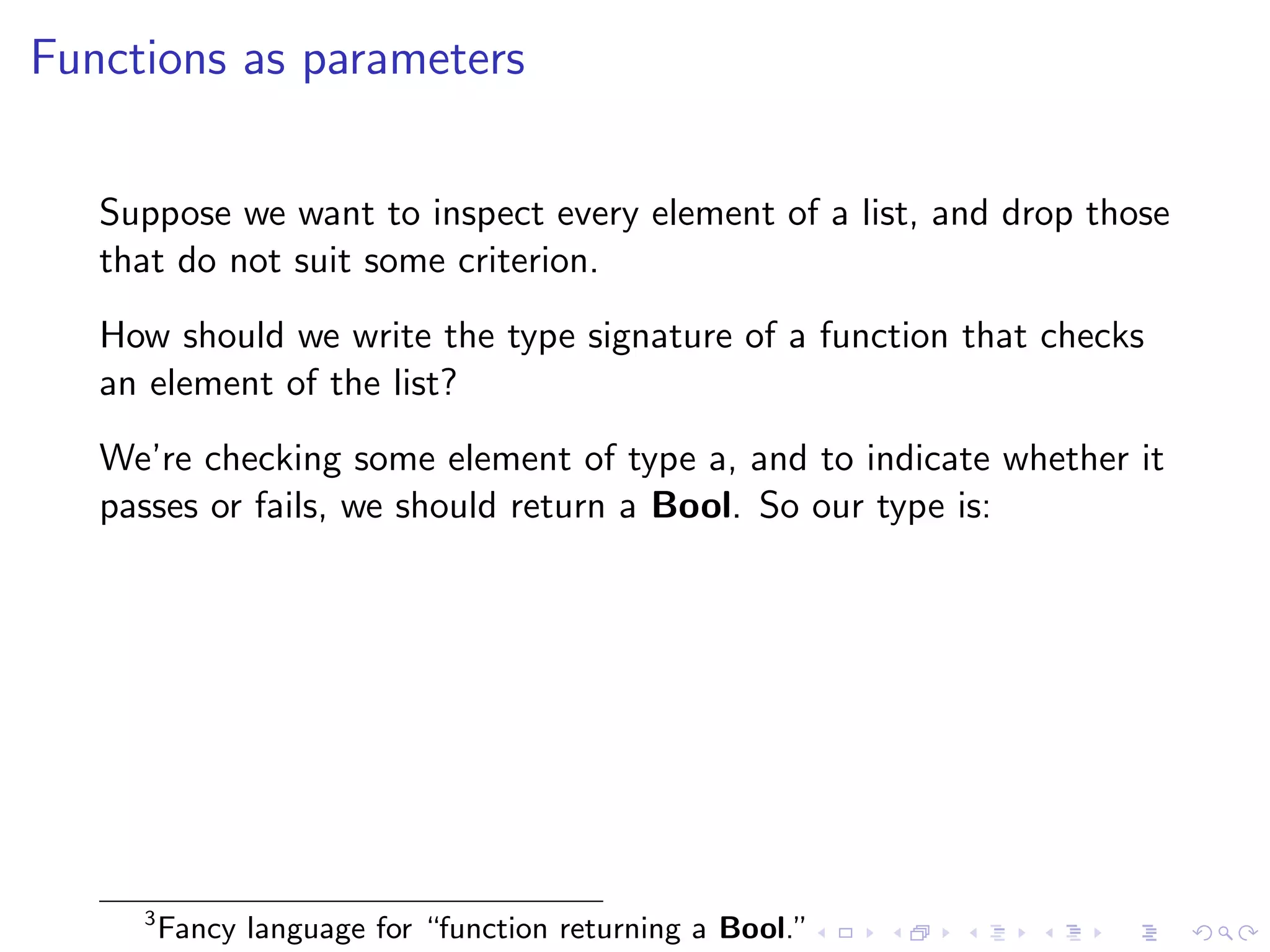
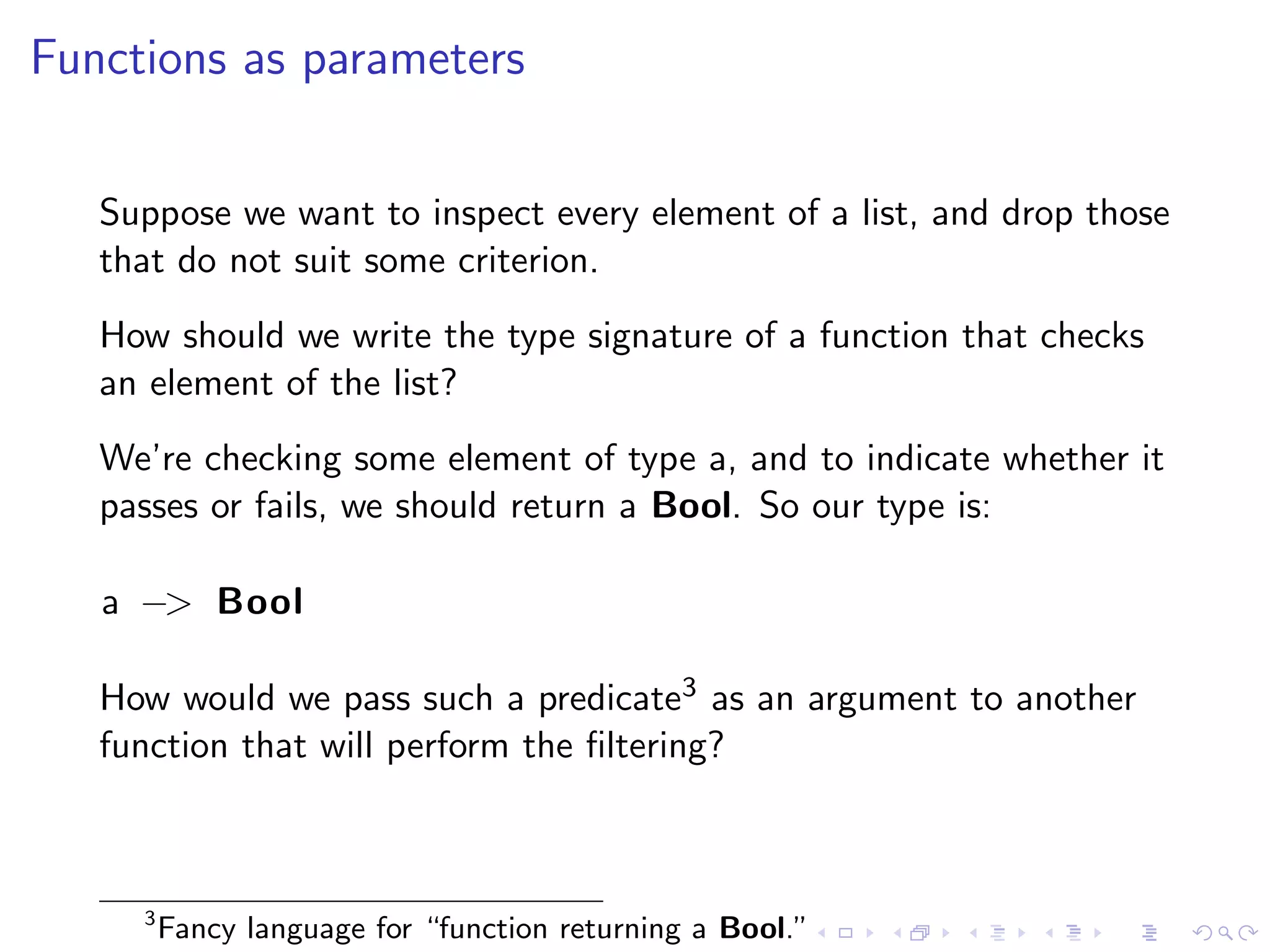
![The definition of filter
Welcome to the world of higher-order programming!
filter : : ( a −> Bool ) −> [ a ] −> [ a ]
filter [] = []
f i l t e r p ( x : xs )
| p x = x : f i l t e r p xs
| otherwise = f i l t e r p xs
Higher-order programming occurs when we pass around functions
as arguments to other functions. Simple, but amazingly powerful!](https://image.slidesharecdn.com/lecture3-091021030809-phpapp02/75/Real-World-Haskell-Lecture-3-23-2048.jpg)
![Turning a polymorphic type into another type
Suppose we want to use the take function on a list of Int values.
How do we figure out what the type of the function will be when
we use it in that context?
Take the type variable a, and substitute our desired type Int
everywhere. So
take : : I n t −> [ a ] −> [ a ]
when applied to a list of Int becomes
take : : I n t −> [ I n t ] −> [ I n t ]](https://image.slidesharecdn.com/lecture3-091021030809-phpapp02/75/Real-World-Haskell-Lecture-3-24-2048.jpg)
![Polymorphism and . . . polymorphism
We can do the same rewrite-the-types trick when we want to see
what the type of a polymorphic function would be when used with
another polymorphic type.
What do I mean by this? Consider take for lists-of-lists-of-lists.
Let’s write a polymorphic list as [b], so a polymorphic list of lists
is [[ b ]] .
We’ll thus replace a with [[ b ]] to get this type:
take : : I n t −> [ [ [ b ] ] ] −> [ [ [ b ] ] ]](https://image.slidesharecdn.com/lecture3-091021030809-phpapp02/75/Real-World-Haskell-Lecture-3-25-2048.jpg)
![Polymorphism vs type inference (I)
Here’s a definition someone wrote for homework, but they got
confused along the way, since we hadn’t covered types yet:
nth n [] = []
nth n ( x : xs )
| n < 0 = []
| n == 0 = x
| otherwise = n t h ( n−1) x s
Try reasoning about this code.
What was the intended type for the nth function?
What is the type of this version, and why?](https://image.slidesharecdn.com/lecture3-091021030809-phpapp02/75/Real-World-Haskell-Lecture-3-26-2048.jpg)
![Polymorphism vs type inference (II)
The original type for nth should have been this:
n t h : : I n t −> [ a ] −> a
But because we didn’t supply a type, and the code wasn’t quite
doing the right thing, the compiler inferred a surprising type:
n t h : : I n t −> [ [ a ] ] −> [ a ]
Notice that its inference was both correct and consistent with what
the code was really doing (but not with what the author initially
thought the code was doing).](https://image.slidesharecdn.com/lecture3-091021030809-phpapp02/75/Real-World-Haskell-Lecture-3-27-2048.jpg)
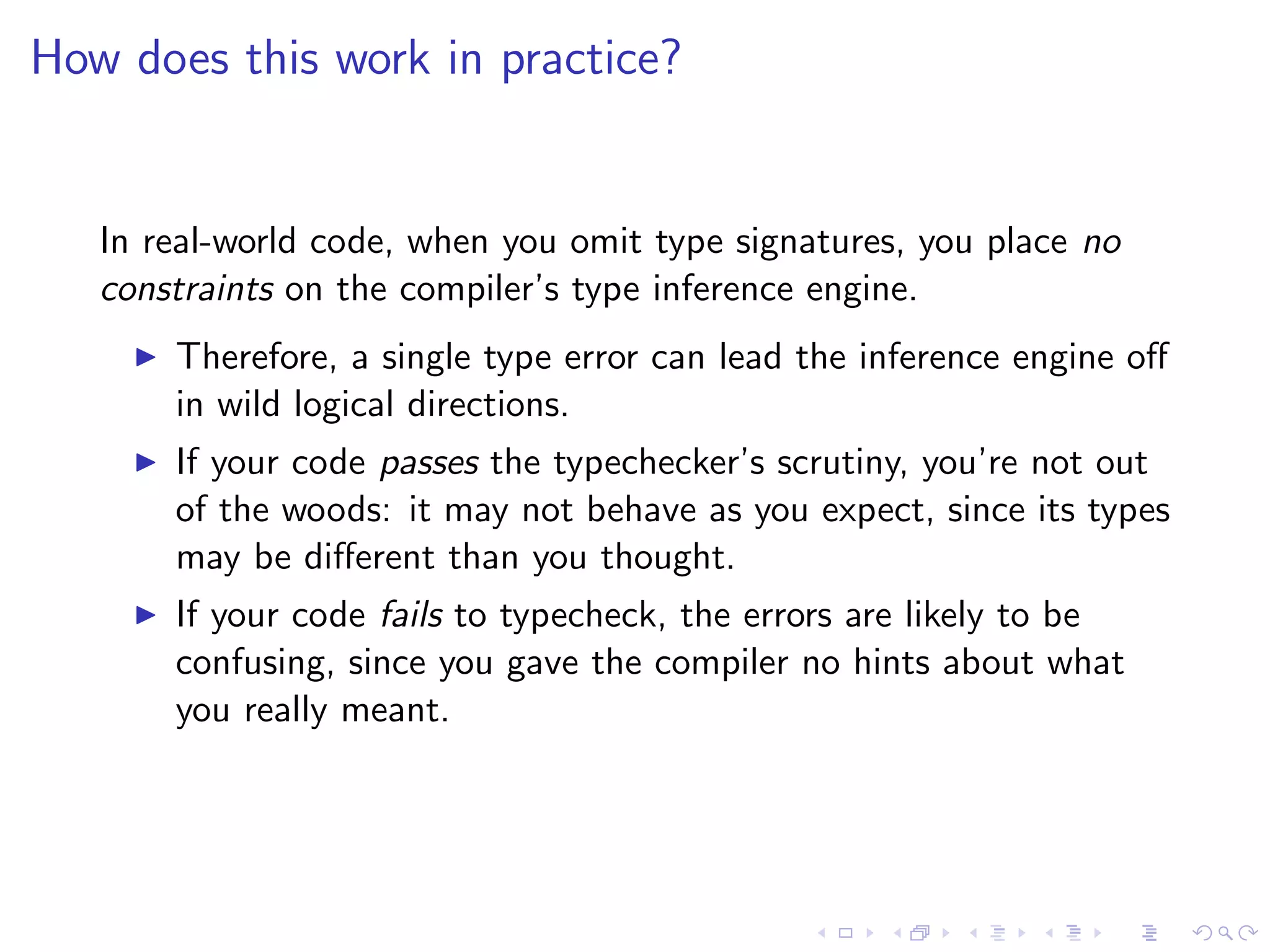
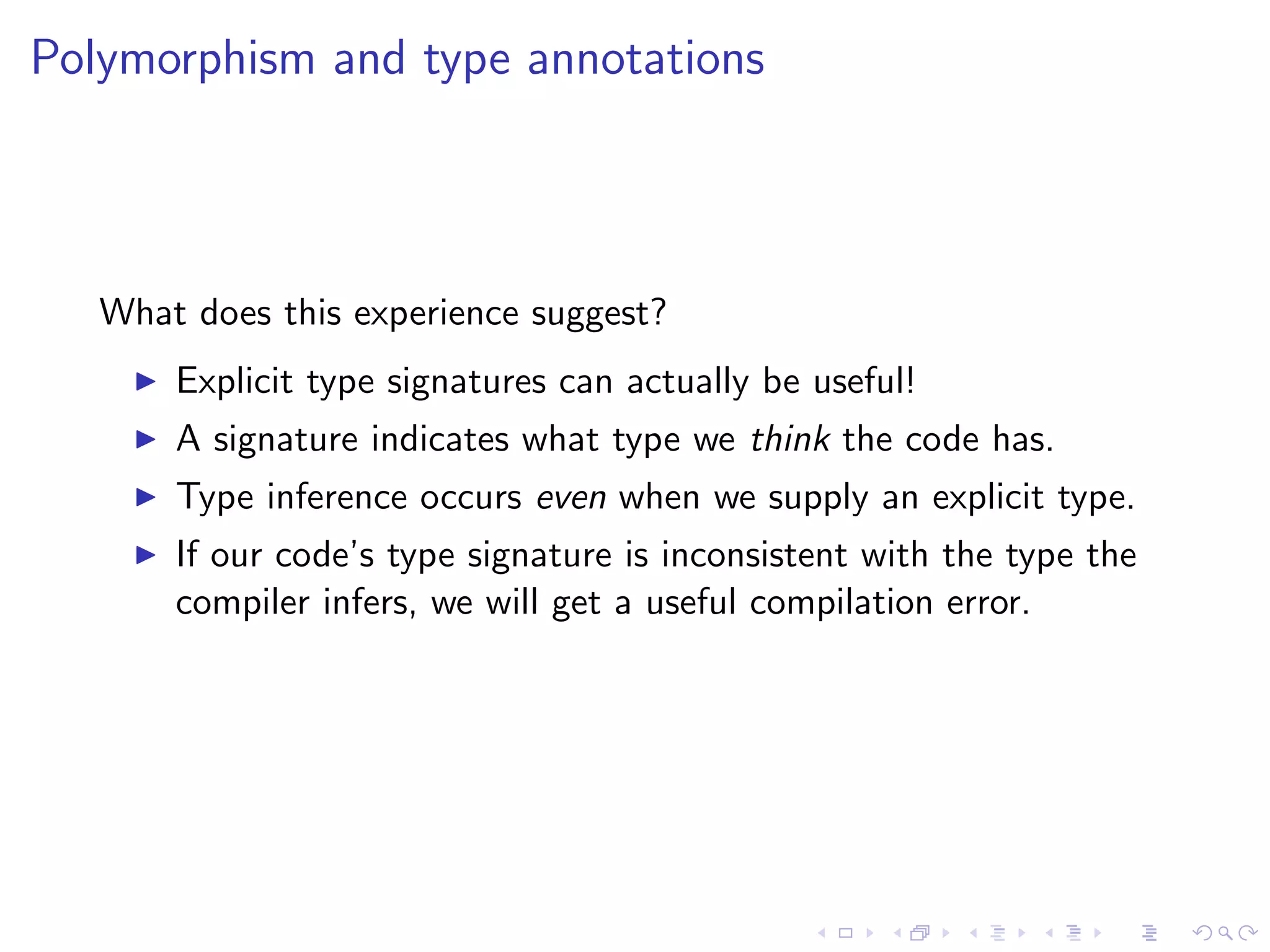
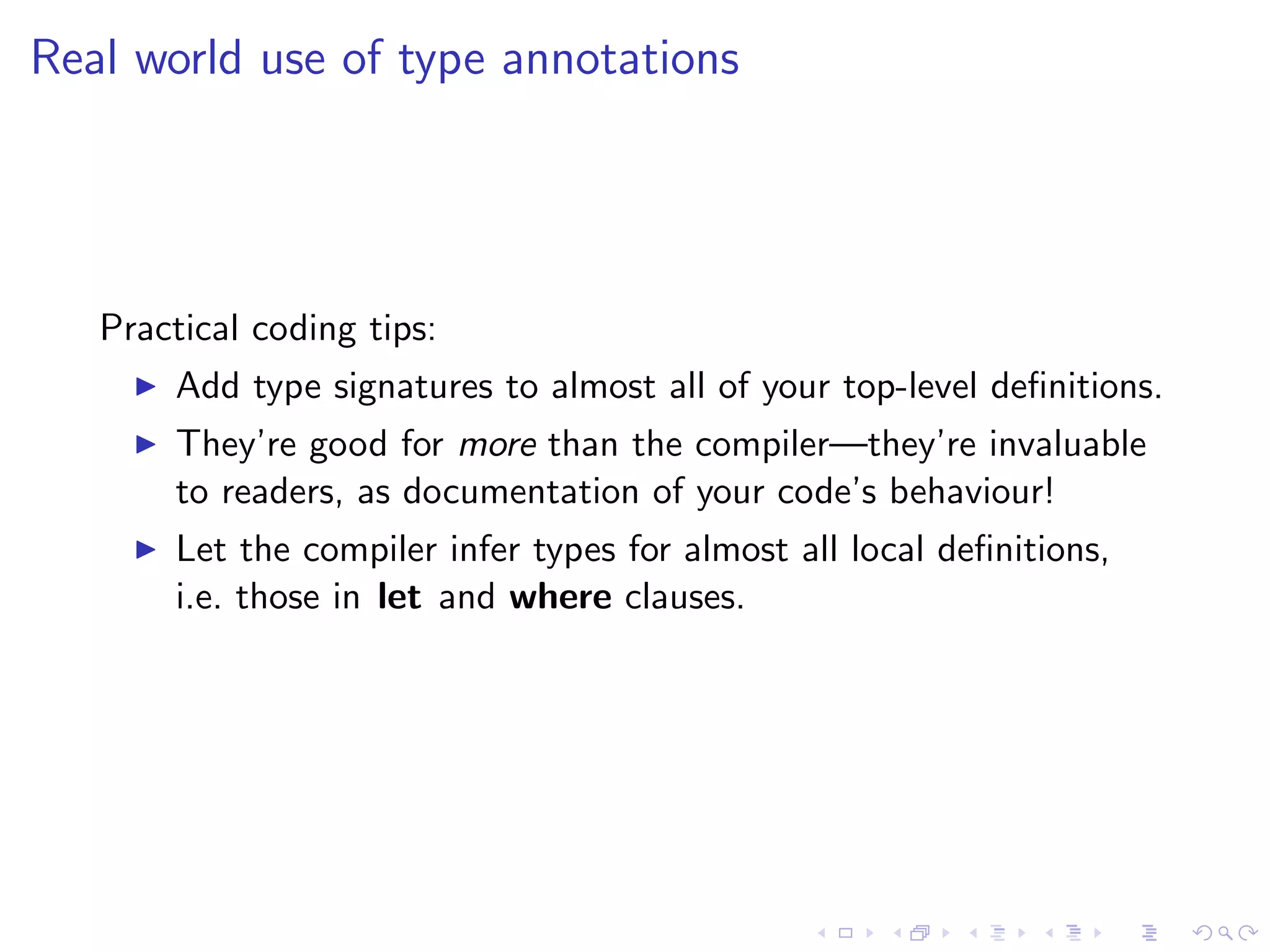
![Inferring behaviour from types
In many cases, we can guess what a function probably does, simply
by examining its type (and sometimes its name):
z i p : : [ a ] −> [ b ] −> [ ( a , b ) ]](https://image.slidesharecdn.com/lecture3-091021030809-phpapp02/75/Real-World-Haskell-Lecture-3-31-2048.jpg)
![Inferring behaviour from types
In many cases, we can guess what a function probably does, simply
by examining its type (and sometimes its name):
z i p : : [ a ] −> [ b ] −> [ ( a , b ) ]
r e p l i c a t e : : I n t −> a −> [ a ]](https://image.slidesharecdn.com/lecture3-091021030809-phpapp02/75/Real-World-Haskell-Lecture-3-32-2048.jpg)
![Inferring behaviour from types
In many cases, we can guess what a function probably does, simply
by examining its type (and sometimes its name):
z i p : : [ a ] −> [ b ] −> [ ( a , b ) ]
r e p l i c a t e : : I n t −> a −> [ a ]
s p l i t A t : : I n t −> [ a ] −> ( [ a ] , [ a ] )](https://image.slidesharecdn.com/lecture3-091021030809-phpapp02/75/Real-World-Haskell-Lecture-3-33-2048.jpg)
![What polymorphism tells us
When we see a polymorphic function like this:
myLength : : [ a ] −> I n t
We can make a surprisingly strong statement about its behaviour:
Its behaviour cannot be influenced by either the type or the
values of the elements in the list it receives.
Why is this?](https://image.slidesharecdn.com/lecture3-091021030809-phpapp02/75/Real-World-Haskell-Lecture-3-34-2048.jpg)
![What polymorphism tells us
When we see a polymorphic function like this:
myLength : : [ a ] −> I n t
We can make a surprisingly strong statement about its behaviour:
Its behaviour cannot be influenced by either the type or the
values of the elements in the list it receives.
Why is this?
Polymorphism is a way of saying “I cannot know anything
about this type, or inspect or manipulate its values.”](https://image.slidesharecdn.com/lecture3-091021030809-phpapp02/75/Real-World-Haskell-Lecture-3-35-2048.jpg)
![What polymorphism tells us
When we see a polymorphic function like this:
myLength : : [ a ] −> I n t
We can make a surprisingly strong statement about its behaviour:
Its behaviour cannot be influenced by either the type or the
values of the elements in the list it receives.
Why is this?
Polymorphism is a way of saying “I cannot know anything
about this type, or inspect or manipulate its values.”
For example, there’s no way to say “myLength should return a
different result for [Char] than for [ Int ].” That’s pretty profound!](https://image.slidesharecdn.com/lecture3-091021030809-phpapp02/75/Real-World-Haskell-Lecture-3-36-2048.jpg)
![Homework (I)
Write a function that drops every nth element from a list. It
should return the removed elements in one element of a pair, and
the remainder of the list in another. Provide a type signature for
your function.
every 3 ” abcdefghi ”
== ( ” c f i ” , ” abdegh ” )
>
Write a function that returns the kth least element of a list,
starting from zero as “the least element”.
kminimum 0 [ 3 , 2 , 1 ]
== 1
>
kminimum 2 ” q w e r t y ”
== ’ r ’
>](https://image.slidesharecdn.com/lecture3-091021030809-phpapp02/75/Real-World-Haskell-Lecture-3-37-2048.jpg)
![Homework (II)
From inspection of the type and operation of the built-in zipWith
function, write your own implementation.
myZipWith min [ 1 , 2 , 3 ] [ 2 , 2 , 2 , 2 , 2 ]
== [ 1 , 2 , 2 ]
>
Write a function that capitalizes the first letter of every word in a
string. It must preserve whitespace and punctuation.
u c f i r s t ” foo b a r ! ! bAZ”
== ” Foo
> Bar ! ! BAZ”](https://image.slidesharecdn.com/lecture3-091021030809-phpapp02/75/Real-World-Haskell-Lecture-3-38-2048.jpg)